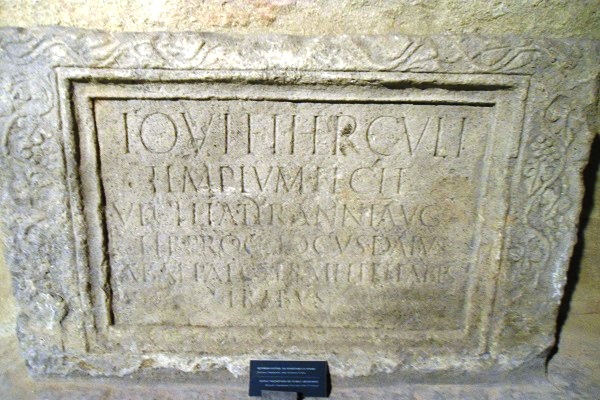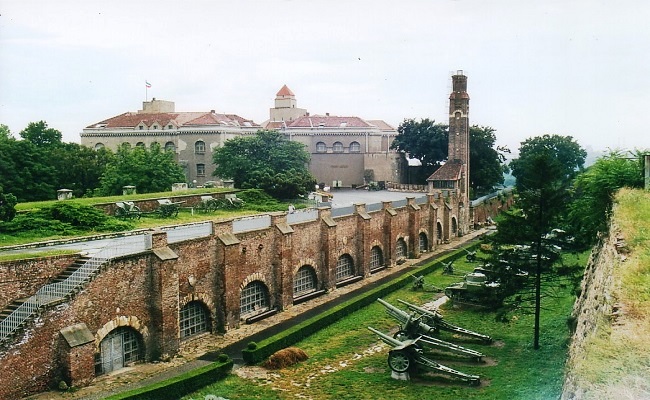The three of us wanted to cancel a walking tour of subterranean Belgrade as it was cold and hadn’t stopped snowing since the night before, but idea of just the three of us going on the tour was very appealing. The meeting point in the city centre was empty until 5 minutes before the walking tour supposed to start when suddenly another 30 people turned up. Our idea of “being on our own” wasn’t very original!
The first stop was the Roman Hall situated in the City Library at the beginning of Knez Mihailova Street. The building used to be the most famous hotel in Belgrade, the Serbian Crown, which was due to be converted into the city library. Architects dug out the basement only to find the foundations of a wall and tower of the main city gate from Roman times, part of the northern defences of the 2nd or 3rd century BC, and around which the settlement of Signidunum (present-day Belgrade) grew. There is a small collection of sculptures, altars and gravestones in the Roman Hall but what is most fascinating is the water pipe which transferred water 10 km away. It is said that when the Ottomans (the present-day Turks) occupied Belgrade and found the pipes they decided to gather all the workers who were working on maintenance and take them back to Constantinople, (present-day Istanbul) to maintain their Roman water pipes.
We crossed the road and entered Kalemegdan Fortress, scene of many very interesting monuments and so much history squeezed into a small place. We passed the Monument of Gratitude to France for her help during WWI, and then entered the Upper Town of the fortress through Karadjordje Gate. On the left we passed the impressive Military Museum, passed through the clock gate built by Austrians during their short occupation of Belgrade in 1715. We also stopped briefly at the Turbe (Tomb) of Damad Ali Pasha, one of the few well-preserved monuments of Islamic culture in Belgrade.
The next stop was the most interesting and the most claustrophobic! Just before we were going to take photos of Belgrade’s famous landmark, Victor, we turned right and a small, heavy, rusty door set into a small hillock was opened for us. We went down steep steps into a well-lit, long and narrow corridor. We passed empty rooms with heavy doors like submarine doors, then we went up into a bunker. The celling was low and some of us, including me, felt the lack of oxygen but the story we heard was worth any discomfort. No one knows when the bunkers were built but they were used intensively after WWII. According to records which were opened recently, the Yugoslav army was stationed here, secretly, soldiers on a two-months-on and two-months-off basis. The question was how did they manage to sneak into the bunkers unnoticed next to the most touristy area of Belgrade without anyone noticing? Old Belgraders remember that this area was closed off every two months for ‘renovations’ but in reality it was closed off for the army and supplies to get into the bunkers. The position of the bunkers is very strategic over the confluence of the Sava and Danube Rivers which explains why their existence was top secret.
From there we moved into the Lower Town of Belgrade Fortress, passing another historic monument, an endowment of an Ottoman statesman hailing from Bosnia, Sokollu Mehmed Pasha, who was born into a Serbian family in Bosnia and then taken away at an early age by the Ottomans to serve as a janissary.
Next stop on our underground walking tour of Belgrade was the military shelter built by the Austrians during their occupation of Belgrade in 1718, called locally Barutana (Gunpowder). During the 1990s the area was leased to entrepreneurs who turned it into a night club. Since then the government realised the importance of the place and made it into a museum. Today it’s a nice exhibition area hosting the National Museum’s Collection of Stone Monuments. This rich display is gathered from different part of Serbia and consists of Roman sarcophagi, gravestones and altars.
Next stop is a long walk to the old, shabby Karadjordjeva Street to see the Vine Lagoon bar. Now if you saw the street you would naturally wonder how you could have a wine bar there. You go into the forecourt of a red garage then enter a lagoon full of corridors, with dark, very low ceilings. This area was known as the delivery place for goods arriving by river which would be pulled by a lift built into the rocks, then distributed all around Belgrade. The remains of the lift can be seen outside the wine bar but also a chimney for the supply of air into the lagoon itself.
Our fascinating walking tour of underground Belgrade finished here with a glass of complimentary wine. The tour lasted two and a half hours and it’s an easy walk but count on lots of steps up and down.













